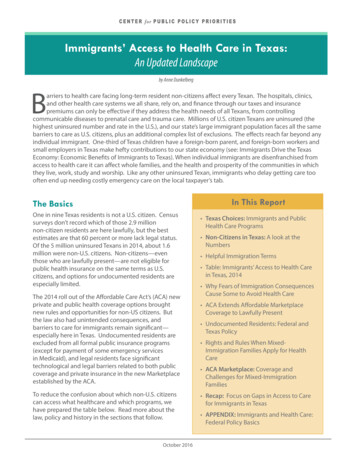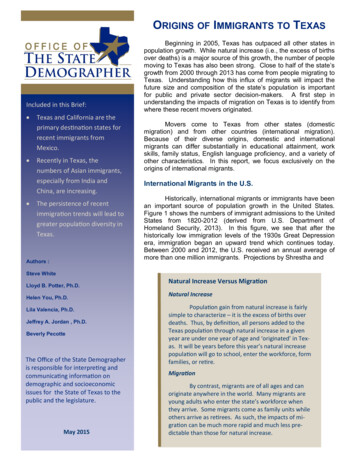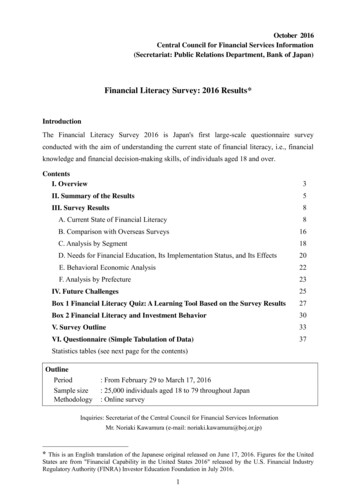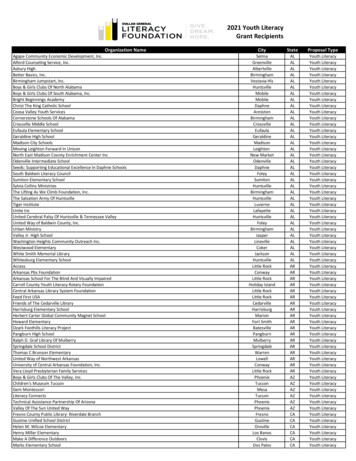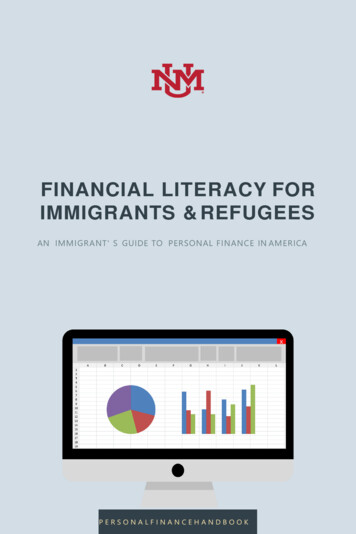
Transcription
FINANCIAL LITERACY FORIMMIGRANTS & REFUGEESAN IMM IGRANT' S GUIDE TO P ERSONAL FINANCE IN AM ERICA
FINANCIAL LITERACY FORIMMIGRANTS & REFUGEES
FINANCIAL LITERACY FORIMMIGRANTS & REFUGEESAN IMMIGRANT' S GUIDE TO PERSONAL FINANCE IN AMERICAEDITORSDr. Reilly White, Jay Shah, Kaleigh Hubbard, & Anissia SavicCONTRIBUTORSSarah McPhee, Kanan Mammadli, Adam Depies, Rene Bustillo,Tristan Collar, & Connor LitesILLUSTRATIONS BYMorgan WatkinsBOOK DESIGNERJoshua ReevesSPECIAL THANKS TODiva Sara Afghani, Christian Slough, Martin Ndayisenga, & Mohamed AlkwazISBN: 978-1-7355417-0-9
SERVICES:CENTER FORFINANCIALCAPABILITYONE-ON-ONE FINANCIALCONSULTATIONSMeet with a Certified PersonalFinancial Coach to receiveadvising that is customizeto YOUR needs.Learn about a variety of financial literacytopics while munching on free food. Atevery workshop there’s the opportunityto win a 100 scholarship!GUSEGDRWWW.CFC.UNN.EDUTAX ASSISTANCEDo you need help filing taxes?We will sit down and answeryour questions, or file themFOR you!FIND USOur office is located in the Deanof Students Office in the UniversityAdvisement and EnrichmentCenter, Building tt85.SOCIALS:
Dedicated to the strong and inspiringrefugees who have risked everythingto choose this place as their home.
TABLE OF CONTENTSIXFORWARD1CHAPTER 129Earning MoneyAdam Depies, KaleighHubbard, & Jay ShahSarah McPhee6CHAPTER 2Receiving Money39CHAPTER 3Spending Money44CHAPTER 4CHAPTER 7TaxesDr. Reilly WhiteAnissia Savic & Jay Shah23CHAPTER 6InvestmentsJay ShahKanan Mammadli16CHAPTER 5Retirement52CreditCHAPTER 8ProtectionTristan Collar & ConnorLitesAdam Depies & ReneBustillo70GLOSSARY
Forward from the UNMCenter for Financial CapabilityFinances are central to much of American society. Your income you make, thetaxes you pay to the government and even the money you spend at your localgrocer, creates a financial web that connects each of us with one another inthe United States. Everything costs money. Understanding how to manageyour money and how you spend can greatly impact your life. Financial literacydoesn’t mean that you must be an expert on all things financial; it just meansthat you understand your income and how you spend your money. There isno magic wand to financial wellness, but there are some basic tools andrecommendations every person can explore to improve their relationship withmoney.Here are three basic tips that can get you started:BudgetingDebtTaxesBudgeting:According to the National Foundation for Credit Counseling, 66% of Americansdo not have a working budget. Most people think that when you have a budgetit means you that your life is going to be limited significantly! This is not thecase! Setting a budget allows for you to make sure you have enough money toix
do all the things you want to do, while making sure to cover your basic expenses(the things you have to pay for). Once you have a workingx
budget, you will learn how to develop better spending habits, and can takecontrol of your monthly and long term expenses.Debt/Credit:Do you have some type of debt? You aren't alone! 87% of people living in theUS are carrying some kind of debt. To many people, debt is simply a part of life,and you may need to take on a loan to pay for a lot of common needs in theUS. For example, college, a home, a car, or even medical bills may result in aperson taking on debt. That's okay, as long as you are diligent about paying onthe debt you owe, and you don't take on more debt that you and your familycan manage. Ultimately, every time you borrow money, you start to create areputation that is associated with the likelihood that you will pay back yourdebts. In the United States, the best measure or indicator of how likely you areto pay back the debts you owe is a credit score. The higher your score, thebetter chance you have to save money when borrowing, and the better chanceyou have to receive a line of credit to borrow. A credit score is vital because itis basically a report card on how you utilize and pay your debt.Taxes:What are they? How do you pay them? Where do they go? When do I have tofile them? The most common taxes you will file is income tax. Income tax is thetax you pay on the money you make. Most of the US Government revenuecomes from income taxes. So, every time you make a little bit of money workinga job, Uncle Sam wants his portion to help pay for the many public resourcesavailable in the US. Usually, your taxes will come out of your paycheck beforeyou get paid, but in some cases you may have to pay additional money if youx
didn't pay enough throughout the year. Most taxes are used to fund roads,schools, and other government funded entities. The UNMxi
Center for Financial Capability will help you file your taxes for free during taxseason (February 1st - April 15th)!If you want to learn more about any of these topics, or if after reviewing thispacket of information, you have remaining questions, please know we are hereto help you. The Center for Financial Capability (CFC) is a financial outreach andeducational program administered through the UNM Dean of Students Office.The program is powered by the University of New Mexico and Nusenda CreditUnion as partners in education. The CFC is a resource devoted to assisting theUNM community on their journey toward becoming financially successful, andwe can help you! We want to help students and their families learn more abouthow to better manage their finances through skill-building,education, and financial relief. Visit c fc.unm.edu to learn more about ourprograms or to schedule an appointment.We hope you benefit from the information in this packet. Please reach out tous if you need one-on-one support.Sincerely,Jacob Silva, Director, UNM Center for Financial Capabilityxi
Chapter 1EARNINGMONEYHOW TO UNDERSTAND YOUR INCOMEPERSONALFINANCEHANDBOOK
Chapter 1You have a job, you have worked, and now you are waiting for payday.While it varies how often we get paid, we all look forward to seeingthe compensation for our hard work. There are different waysthat your paycheck may arrive. You may receive a paper paycheck that is mailedto you, or you may be asked to pick it up. As the world becomes increasinglypaperless, your employer may use Direct Deposit instead of paper checks.Whether you are paid with paper or through an online portal, your paycheckand pay stub hold all the information explaining why you’re being paid theamount you are.KEY TERMS1. Deductions: Money that is taken from your (the employee) gross pay.Common deductions are withheld taxes, benefits, andemployeecontributions. Deductions can be taken out pre-tax or post-tax.2. Direct deposit: When you provide your banking account and routingnumber to your employer so that your paycheck is automatically depositedinto your account.3. Employee: That's you!4. Employer: The company, organization, or individual that/who pays you foryour work.5. Gross pay/gross wages: The amount of money you are owed beforedeductions: pay rate x pay period gross pay.6. Net pay: The amount of money you actually receive: gross pay - taxes &2
deductions net pay.7. Paycheck: The money the employer pays you for your work for a setamount of time.3
5.7.8. Pay stub: An itemized explanation of your pay rate, hours worked, taxes,deductions, pay period, and the amount being paid to you. The pay stub iseither physically attached to the check or is accessible through an onlineportal.9. Pay date: The date which your check is available for depositing or when yourpaycheck may be directly deposited.10. Pay rate: The rate you are paid (i.e. 8/hour).11. Pay period: The range of dates you are being paid for.12. YTD: An abbreviation for Year-To-Date, often used to represent the amountthat has been earned or charged within a calendar year.EXAMPLEAmena Sabari and her family recently moved to Albuquerque from Afghanistan.Amena and her husband, Mohamad, both work full-time jobs, while theirchildren, Roya, 12, and Raheem, 10, are in school. Amena got a job at theUniversity of New Mexico as an accounting clerk in the purchasing department.She started the job at the beginning of 2020 and makes 20 an hour. Below isan example of what her first paycheck and pay stub would look like.3
A: Employer Informationc. Federal TaxB: Employee Demographicsd. NM State TaxC: Pay PeriodK: Deductions this PeriodD: Pay DateL: Year-to-Date DeductionsE: Type of Income(Itemized)F: Pay RateM: Gross Pay, Year-to-DateG: Hours WorkedN: Total Year-to-Date DeductionsH: Total Gross PayO: Net PayJ: DeductionsP: Pay Totala. FICA MedicareQ: Deductions this Periodb. Social SecurityR: Net PayQUESTIONSQuestion: What is the difference between Pre-Tax and Post-Taxdeductions?Pre-tax deductions are deductions that are applied to your income before youhave been taxed. These deductions often include healthcare costs like insurancepremiums and flexible spending accounts. Post-tax deductions are deductions4
that are applied to your income after you’ve been taxed. These deductions ofteninclude debts owed to the employer, such as uniform costs5
and parking charges if you are required to purchase a parking permit fromyour employer.Question: Do I need to save my pay stubs?It is recommended that employees keep their pay stubs for at least one year.Pay stubs can be an easy source for income verification in the event of a loanapplication, apartment application, or salary negotiation. Your pay stubs alsohelp you track your taxes and deductions. Some employers offer online paystubs, which makes it easier to refer to them and means you don’t have to storepaper pay stubs.Question: Is there a benefit of paper checks vs direct deposit?There is no difference in the amount of money you receive or the amount oftaxes taken out between a direct deposited check and a paper check. Themajor difference is time. Physical checks have to be processed and printed,and then you either have to wait for it to be mailed or go pick it up, whichmay be inconvenient if you do not work the day the checks are available. Youwill also have to make your way to a bank to deposit the check.Direct deposit means that, when your paycheck is processed by your company,the money will be automatically deposited in the account of your choice, andyou only have to wait for your bank to process the deposit.Question: What is the difference between a calendar year and afiscal year?Calendar years are the 12-month period between January 1st and December5
31st. In some companies, the fiscal year is used, which can be any 12-monthperiod used for payment and budgeting purposes. The fiscal year of theFederal Government runs from October 1st to September 30th.6
Chapter 2RECEIVINGMONEYHOW TO RESPONSIBLY MANAGE YOUR MONEYPERSONALFINANCEHANDBOOK
Chapter 2There are multiple ways to receive money. While working, we oftenreceive money in the form of cash, a check, or through direct deposit.When we receive money from relatives, its often ‘wired’ tous directly to our bank accounts. How does this work? What happens to yourmoney after you deposit it into your bank account? How can you access yourmoney? We will talk about multiple ways of accessing your money in your bankaccount.Bank AccountsThere are two major account types: checking accounts and savings accounts.To open a bank account in the United States, you are required to have twothings: (1) an identification number and (2) proof of identity and address via avalid, government-issued photo ID.Don’t worry if you currently do not have a legal immigration status and/or areunable to have a social security number. You can also open bank accounts usingan Individual Taxpayer Identification Number (ITIN) provided by the U.S.government’s tax agency, the Internal Revenue Service (IRS). Manyundocumented immigrants pay taxes to the government in this way.KEY TERMS1. Checking account: A checking account is the one account that allows youto easily access your money, spend it, and withdraw it using a debit card.7
Usually, these do not pay very much in interest. This is the account you usewhen you write checks.8
2. Debit card: Banks or credit unions issue these when you open a checkingaccount. This allows you to buy items without using cash.3. Check: Checks are documents that are written, signed, and dated that directyour bank to pay a specific amount of money to another person or company.4. Maintenance fee: Some banks charge fees to have accounts, usuallybetween 5 and 20 per month. These fees apply particularly to checkingaccounts, but they can be waived if the account has a large enough balance.5. Overdraft fee: A fee bank charges when you spend more than what youhave in your checking account. The average overdraft fee is about 34 forbanks.6. Savings account: These are bank accounts that earn interest. When youcreate a savings account with a bank, you agree to let them hold onto yourmoney — in return, you receive a small interest payment each month.7. ATM (Automated Teller Machine): ATMs are electronic banking outletsthat you can find in many different locations. If you have a debit card, youcan use these machines to take out money directly from your account. If themachine is not owned by your bank, you may be charged a fee (usuallybetween 2 and 4) per transaction.8. PIN (Personal Identification Numbers): These are special four-digit codes(called a ‘PIN’ number) that allow you access and use your debit card to takeout money and pay for things. Your PIN must be kept a secret (known onlyto you) so other people cannot have access to your money.8
9
CHECKING ACCOUNTSA checking account allows you to easily access your money, spend it, andwithdraw it using a debit card. Debit cards are issued by banks or credit unionswhen you open a checking account. You can use the card to take cash from anATM. When you open an account, you can ask for a checkbook from youbank/credit union, and you can write a check to people when you pay them. Inthe example below, you can see how a check should be written:It’s important to remember that, for a check to be valid, it must be signed. Theamount of money that you write a check for must be written out as well. Thisensures the bank does not make a mistake when it issues payment. The number(at the top right corner) is unique for each check. The numbers on the bottomof the check include the routing number (the bank where your account islocated) and the account number (the number of your checking account at thebank). When you receive a check, it takes two business days for a check depositto ‘clear’, which enables you to use the money for other things.9
When you have a checking account, the same account number and routing10
number are used to set up a direct deposit account. These accounts (which wementioned in Chapter 1) allow you to receive your paycheck directly into yourchecking account at the end of every pay period.Checking accounts often have fees associated with them. Many banks chargebetween 10 and 25 for checkbooks, and some also charge ‘Maintenance fees’each month. Overdraft fees occur when you spend more money than youcurrently have in your bank account. These can be expensive and should beavoided at all times. Keep a close record of your checking account balance toensure that you do not accidentally withdraw more money than you have.EXAMPLESExample 1Mike goes to an old local restaurant for dinner with his family. They have a sign10
saying, 'CASH ONLY.' Mike doesn’t carry cash always, but he has his11
debit card from his bank. He finds an ATM, inserts his card, and enters his PINnumber. After Mike enters his PIN, he withdraws 40 to pay for dinner.Example 2Mike received a check for 1,000 for selling his motorcycle. After signing theback of the check to make the deposit valid, he takes the check to his local bank.The bank gives him the following receipt:11
The receipt confirms he deposited the check. The balance before depositing thecheck was 7,761.82; this is called the available balance. This is money that hecan spend now. Since the check will take two business days to clear, he cannotuse that money yet. His account balance is 8,761.82 because it includes the 1,000 deposit he just made. If Mike does not spend any more money, hisavailable balance will also be 8,761.82 in two business days.Example 3Mike bought a new house, and he is planning to a make mortgage payment.One of the easiest ways to make the payment is to set up direct deposit withthe company. He gives them his routing number and his checking accountnumber. The bank will then automatically pay his mortgage provider everymonth on the same date.Example 4Mike opened a new checking account, and his accounts have both amaintenance fee and an overdraft fee. He pays 5 every month. His checkingaccount has around 50, and he plans to buy new clothes using his debit cardfor 65. His payment goes through, but his checking account is now - 15(negative 15). His bank charges him a 30 overdraft fee, making his checkingaccount balance - 45 (negative 45).SAVINGS ACCOUNTSSavings accounts can be used to store money for many purposes. Unlike achecking account, you usually can’t access this with a debit card, although some12
banks allow you to write checks that draw from your savings account directly.Unlike checking accounts, savings accounts often limit how many13
times you can have transactions. In return, depositors receive higher interestrates. Interest is a payment the bank makes to an individual account for allowingthem to hold your money. It is expressed as an annual percentage of your totalbalance.If a savings account promises a 1% annual interest rate, the bank promises topay you 1% of your total deposit balance each year. If you have 10,000 in yoursavings account, this means you will receive an extra 100 each year as interest( 10,000 x 0.01 100). Savings accounts might have a minimum requiredbalance and a monthly fee, particularly for small balances. Importantly, mostbanking institutions are insured by the Federal Deposit Insurance Corporation(FDIC), which insures individual deposits up to 250,000. This means that, if the bank were to fail or close due to insolvency,your deposits would be protected and guaranteed by the US government.EXAMPLEJon is planning to open a savings account. He looks at Bank A, which offers 1.5%interest, and Bank B, which offers 1%. Assuming Jon wants to get high interest,he will pick Bank A.RESOURCESNerdWallet — What Is a Checking at-is-a-checking-account/13
The Balance — How to Write a ck-401939514
Islamic FinanceSharia-compliant finance follows the main principles of the Islamic financialsystem, which prohibits payment and the receipt of interest (riba). Islamic lawdoes not recognize money as a store of value and commodity but only as amedium of exchange. In that form, returns (and debt securities) must be tied toan asset. Banks that provide Islamic Banking Services that operate in the UnitedStates include J.P. Morgan, Lariba – American Finance House, GuidanceResidential, and Devon Bank.Islamic law prohibits the following:i. Paying or charging interest (riba)ii. Investing in businesses involved in prohibited activities (trading pork oralcohol)iii. Speculation (maisir)iv. Uncertainty and risk (gharar)There are multiple instruments that are aligned with Islamic law.Murabaha: Add markup or cost plus sale. When an asset is financed with abank, the bank pays the full price and adds the interest on top of the price ofthe asset. A customer (following Islamic law) can pay a predetermined lumpsum amount or installments.Example: When a customer would like to purchase a car from a dealer, abank that provides Islamic financing will purchase the car and add theinterest payment on top of the car’s selling price. If the value of the car is14
10,000 and the interest payment is 1,000, the customer will buy the car for 11,000 from the bank.15
Ijara: More of a leasing contract, where a bank purchases an asset and lets thelessee lease it to a customer in exchange for a fixed payment. In the beginning,ownership will belong to the financiers; however, ownership may graduallytransfer to the lessee.Example: When a customer would like to purchase a house, the bank willbuy the house and then will let the customer lease the property for apredetermined amount. At the end of the period, the customer will own theproperty.Mudaraba: A trustee financing contract, where one party contributes capitaland the other provides expertise. Profits are shared based on a predeterminedratio and investors are not guaranteed a return and bear any financial loss.Musharaka: A form of equity participation where parties contribute capital andprofits are shared on a predetermined ratio. Losses are shared based on thecapital contributions. Partners control the investment and are liable for theactions of others.Sale Contracts: Deferred-payment sale (bay’ mu’ajjal) and deferred-deliverysale (bay’salam). In a deferred-payment sale, delivery of the product is takentoday, and payment is deferred until an agreed upon time. Assuming there isno extra charge for the delay, the payment can be made lump sum or inpredetermined fix installments. In a deferred-delivery sale, payment is duetoday for a product that will be delivered in the future.15
Chapter 3SPENDINGMONEYHOW TO RESPONSIBLY BUDGET YOUR MONEYPERSONALFINANCEHANDBOOK
Chapter 3Responsibly spending your money involves budgeting. What isbudgeting? Budgeting is allocating your paycheck appropriately inorder to pay for expenses. It is critical to ensure your bills are paidon time, as well saving for your future.KEY TERMS1. Budget: A plan for spending and saving money based on a person’s goalsduring a given period of time.2. Expenses: Money a person spends.a. Fixed expenses: expenses that stay about the same every month, suchas rent, insurance, or car loan paymentsb. Variable expenses: expenses that may not cost the same from monthto month, such as groceries, gas, or credit card bills3. Income: Money a person receives.4. Gross income: An individual’s total pay before taxes or other deductions.5. Net (disposable) income: An individual’s income after taking taxes andother deductions into account.6. Discretionary income: The amount of an individual’s income that is left forspending, investing, or saving after paying taxes and paying for personalnecessities (i.e., food, shelter, clothing, etc.). Usually spent on luxury items,vacations, and nonessential goods and services (i.e. Netflix, Xbox, etc.).7. Needs: An individual’s basic requirements that must be fulfilled in order tosurvive (i.e., food, electricity, etc.).8. Wants: Nonessential goods and services (i.e. luxury items, vacations, etc.).17
9. Savings: Funds set aside to be used at a later date.10. Cost of living: The average cost of a variety of expenses for living,18
including rent/mortgage, insurance, utilities, food, etc.CREATING A BUDGET1) Start your budget by determining what your monthly net income is basedoff your previous pay stubs. If you are starting a new job soon, there arevarioust .adp.com/resources/tools/calculators).If your monthly net income is not consistent, determine your lowest potentialmonthly income. Taking a conservative route will allow you to budget for theworst-case scenario. Before you move on to step two, make sure that you taketaxes into account. A lot of employers will automatically take taxes out of yourpaycheck if you choose that option; however, if you decide to opt out, you haveto make sure to set aside the approximate amount owed.2) List out your essential monthly expenses, or your needs. You can separatethem between fixed and variable expenses (view Figure 3.1). Doing so may helpyou to organize your costs based on when they need to be paid. This includes:a. Mortgage or rentb. Insurance (home, health, etc.)c. Student loansd. Utilities (electricity, gas, water/sewer, internet)e. Food (groceries)f. Transportation18
Note:19
a. If your monthly mortgage/rent is more than 30% of your net income, youshould consider moving somewhere cheaper or getting a roommate.b. If your monthly transportation expense is more than 15% of your netincome, you should consider alternative options (i.e., bus/bike), carpoolingto work, or moving closer to work.c. If your groceries cost more than 300 per adult, you should considerbuying in bulk, buying store brands, and other frugal purchasing measures.3) List out your savings goals, retirement plans, and emergency fund goals. Ageneral rule of thumb when building an emergency fund is to set aside threeto six months’ worth of expenses, but twelve months should be the ultimategoal. (Add up all of your expenses for one month and multiply that number bythe number of months you decide is sufficient to save for.) The best place tohold your emergency fund is in an FDIC-insured savings account. This allowseasy liquidation (withdrawal) while still earning interest.Retirement plans should be considered after your debts are paid off and youhave built a healthy emergency fund. Then, you should set aside some moneyfor any future goals you have, such as buying a house, vacation, or future family.4) Anything left over after you’ve completed steps one through three isconsidered discretionary funds. This can be used for wants, such as shopping,hobbies, or fast food.Below is an example budget:19
FigureSeptember Income3.19/1/2020Biweekly paycheck 8009/15/2020Biweekly paycheck 800 1,600TotalFixed Expenses9/5/2020Car payment and insurance due 1209/5/2020Health insurance due 509/10/2020Cell phone bill due 509/13/2020Student loan payment 509/13/2020Credit card bill 509/20/2020Rent due 4009/20/2020Utilities and water bill due 80Total 800Groceries ( 40 x 4 weeks) 200Household items (soap, toilet paper, etc.) 50Gas 40Total 290Emergency savings 110Retirement fund 160Savings for your goals 80Total 350Variable ExpensesSavings Accounts 1,440Total Fixed and Variable Expenses and SavingsTotal Net (Discretionary) Income20 160
*This budget is NOT comprehensive, and the numbers are arbitrary. It is only meant forexample purposes.Let’s follow the steps in “Creating a Budget.” We will assume that the owner ofthe budget is named Linda.1) Linda determines that her net income is 1,600 a month after taxes.2) She has listed her expenses and even divided them up between fixed andvariable expenses. This makes it easier for her to determine what expenses shehas every month and which ones may not stay the same from month to month.She knows approximately how much she will need to spend, which is about 1,090 a month.3) Linda needs to decide how much to save for emergency savings, retirement,and her future goals. She decides to allocate about 7%, 10%, and 5% of her netincome for these purposes, respectfully. (These percentages are only meant touse for example purposes; they are not intended to be used as suggestions.)4) She has allocated a total of 1,440 per month on expenses and savings. Thatmeans she has 160 left that month to do whatever she would like to do. Shecan go out to eat, shop, or go to the movies. It is important to reward herselffor allocating her money correctly. Then, she will not feel too overwhelmed andcan continue to do the same thing next month.QUESTIONSQuestion: How do I budget for gifts and special occasions?You should use your discretionary income to budget for special occasions. Thatmay mean saving some money from the previous month as well to ensure that21
you can afford what you want, or it may mean that you have a little less thatmonth to spend on yourself.22
Question: What if I have trouble prioritizing and make a mistake?That is exactly what a budget is for. If you do not meet your goals one month,simply start over the next. It may be difficult at first to get used to it, but as longas you keep trying, you can be successful.Question: What about my spouse and/or family?The same rules in this section apply, just with different parameters. If you havea spouse that you share income and expenses with, you should make acombined budget. Figure out the total income that both of you bring in anddeduct the total amount of expenses and savings needed for that month todetermine your discretionary income. If you have a family, there will be otherexpenses that you will have to account for. Potential things such as diapers,school supplies, and extra groceries should all be considered and included inyour budget (typically under variable one,utilizeM int(https://www.mint.com/). Mint is a free, web-based personal financialmanagement service. Mint links up with most large financial institutions to helptrack your spending as well as other various facets of your finances.If you do not have internet access, Excel ALS has various budgeting templatesfor your use that will help with the budgeting process.22
Chapter 4CREDITHOW TO RESPONSIBLY BORROW MONEYPERSONALFINANCEHANDBOOK
Chapter 4Credit refers to the loaning of goods or money on the promise to bepaid back at a later date. For consumers, the most common exampleof this is a credit card. In this situation, a credit card company agreesto lend you money on your credit card, and you agree to pay them back at alater date.Almost any type of loan that you can think of is an example of credit:automobile financing, mortgage loans, and personal loans. The people whooffer the money are called “creditors” or “lenders,” and the people receiving themoney are referred to as “debtors” or “borrowers.” Your credit score is anextremely important factor that affects all of your daily life and can determinewhether or not you can qualify to buy a house, car, or even rent an apar
debts. In the United States, the best measure or indicator of how likely you are to pay back the debts you owe is a credit score. The higher your score, the better chance you have to save money when borrowing, and the better chance you have to receive a line of credit to borrow. A credit score is vital because it
